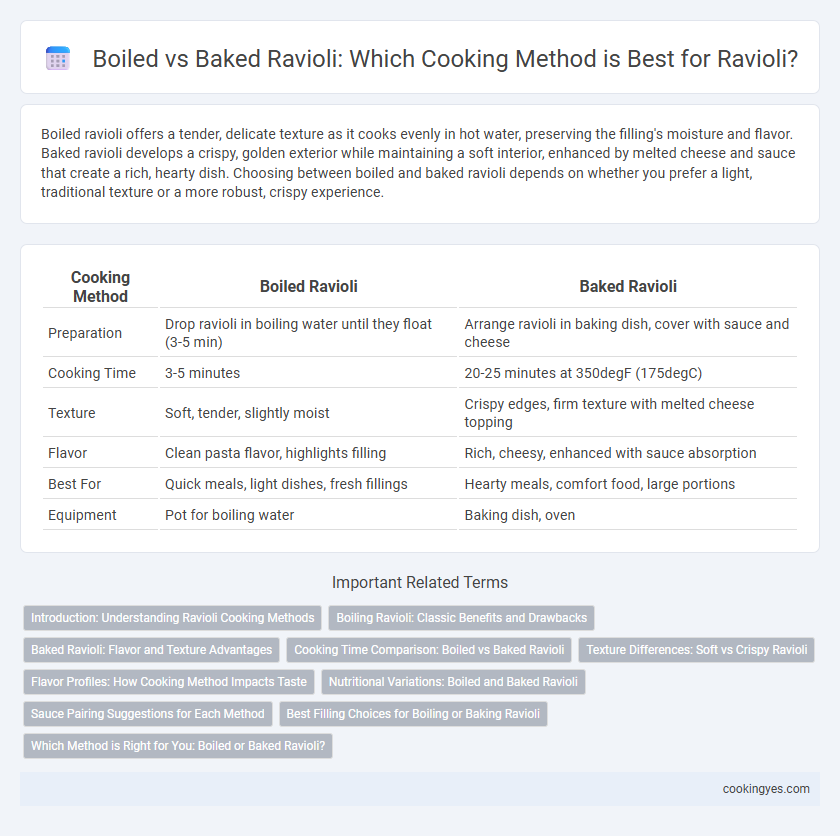Boiled ravioli offers a tender, delicate texture as it cooks evenly in hot water, preserving the filling's moisture and flavor. Baked ravioli develops a crispy, golden exterior while maintaining a soft interior, enhanced by melted cheese and sauce that create a rich, hearty dish. Choosing between boiled and baked ravioli depends on whether you prefer a light, traditional texture or a more robust, crispy experience.
Table of Comparison
| Cooking Method | Boiled Ravioli | Baked Ravioli |
|---|---|---|
| Preparation | Drop ravioli in boiling water until they float (3-5 min) | Arrange ravioli in baking dish, cover with sauce and cheese |
| Cooking Time | 3-5 minutes | 20-25 minutes at 350degF (175degC) |
| Texture | Soft, tender, slightly moist | Crispy edges, firm texture with melted cheese topping |
| Flavor | Clean pasta flavor, highlights filling | Rich, cheesy, enhanced with sauce absorption |
| Best For | Quick meals, light dishes, fresh fillings | Hearty meals, comfort food, large portions |
| Equipment | Pot for boiling water | Baking dish, oven |
Introduction: Understanding Ravioli Cooking Methods
Boiled ravioli involves cooking the pasta in rapidly boiling water until it reaches a tender texture, preserving the delicate filling inside. Baked ravioli, often breaded and layered with sauce and cheese, offers a crispy exterior and a rich, casserole-style dish. Choosing between boiling and baking depends on the desired texture and flavor intensity for the ravioli meal.
Boiling Ravioli: Classic Benefits and Drawbacks
Boiling ravioli ensures even cooking and maintains the delicate texture of the pasta while allowing the filling to stay tender and moist. This method preserves the authentic flavor profile and prevents the ravioli from drying out, making it ideal for fresh or frozen varieties. However, boiling can sometimes cause the ravioli to become waterlogged or break apart if overcooked, requiring careful timing and stirring.
Baked Ravioli: Flavor and Texture Advantages
Baked ravioli offers a richer flavor profile due to the caramelization that occurs during baking, enhancing the dish with a slightly crispy exterior and a warm, gooey interior. The texture contrast between the crunchy topping and tender pasta creates a more complex and satisfying eating experience compared to boiled ravioli. This cooking method also allows for layering with cheese and sauce, intensifying flavors and providing a hearty, comforting meal.
Cooking Time Comparison: Boiled vs Baked Ravioli
Boiled ravioli typically cooks in 4 to 6 minutes, resulting in a soft and tender texture. Baked ravioli requires a longer cooking time, about 20 to 25 minutes at 375degF, which crisps the edges and melds flavors in the sauce. The choice between boiling and baking directly affects both preparation time and final texture.
Texture Differences: Soft vs Crispy Ravioli
Boiled ravioli typically has a soft, tender texture due to cooking in water, which allows the pasta to absorb moisture evenly and remain delicate. Baked ravioli develops a crispy exterior as the dry heat creates a golden crust while maintaining a softer interior, offering a contrast in texture. The choice between boiling and baking impacts the overall sensory experience, with boiled ravioli appealing to those who prefer softness and baked ravioli suited for those seeking a crunchier bite.
Flavor Profiles: How Cooking Method Impacts Taste
Boiled ravioli boasts a tender, delicate texture that allows the subtle flavors of the filling to shine, especially with fillings like cheese or spinach. Baked ravioli develops a crispy, golden exterior that adds a rich, toasted flavor and enhances heartier fillings such as sausage or beef. The choice between boiling and baking directly influences the overall taste experience by balancing softness with texture and highlighting different flavor intensities.
Nutritional Variations: Boiled and Baked Ravioli
Boiled ravioli retains more moisture and typically has fewer added fats, resulting in lower calorie content and less fat compared to baked ravioli. Baked ravioli often contains higher levels of calories and fat due to the use of oils or cheese toppings during baking. Both methods maintain protein and carbohydrate levels from the pasta and filling, but baking can slightly reduce water-soluble vitamins due to heat exposure.
Sauce Pairing Suggestions for Each Method
Boiled ravioli pairs exceptionally well with light, delicate sauces such as marinara or a simple garlic and olive oil blend, allowing the pasta's texture and filling to shine without being overwhelmed. Baked ravioli, with its crispy edges and richer texture, complements thicker, creamier sauces like Alfredo or a hearty meat ragu that meld seamlessly with the melted cheese topping. Choosing the right sauce enhances the overall flavor profile and balances the cooking method, creating a satisfying ravioli dish.
Best Filling Choices for Boiling or Baking Ravioli
Cheese-filled ravioli, such as ricotta and mozzarella blends, are ideal for boiling since the delicate filling retains moisture and achieves a creamy texture. Meat-based fillings like ground beef or sausage are better suited for baking, as the heat allows the flavors to intensify and the edges to become crisp. Spinach and mushroom combinations work well with both cooking methods, offering versatility depending on whether a tender or slightly crispy finish is desired.
Which Method is Right for You: Boiled or Baked Ravioli?
Boiled ravioli offers a traditional, tender texture with a quick cooking time, ideal for those seeking a classic Italian experience. Baked ravioli provides a crispy, golden exterior with a rich, melted cheese topping, perfect for casseroles and family-style meals. Choosing between boiled or baked depends on your preferred texture, presentation, and cooking convenience.
Boiled ravioli vs Baked ravioli for cooking method Infographic

 cookingyes.com
cookingyes.com